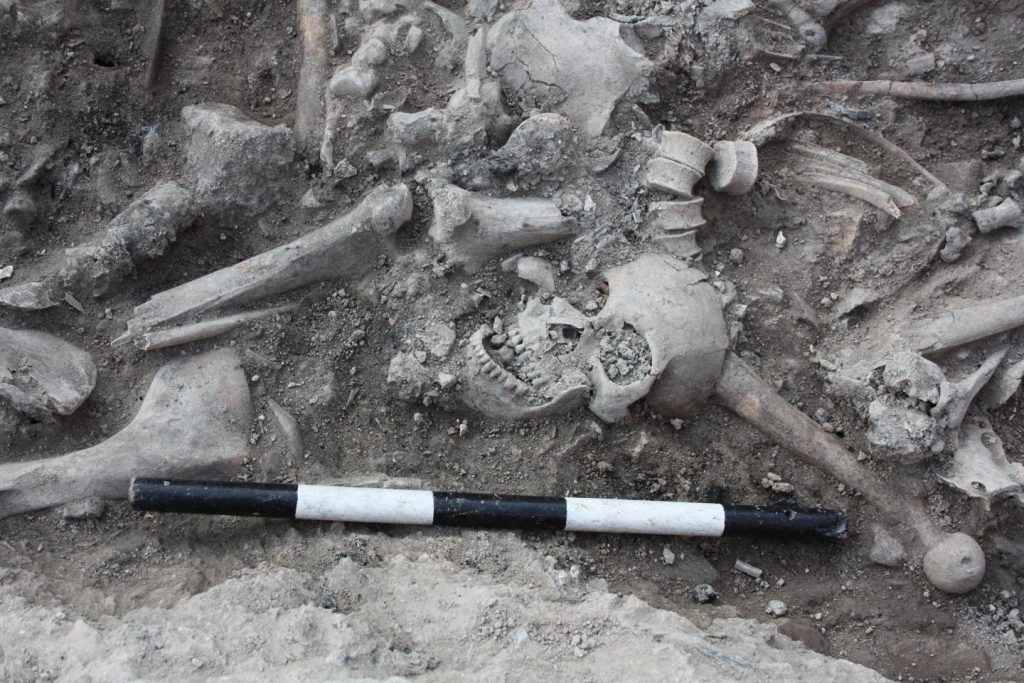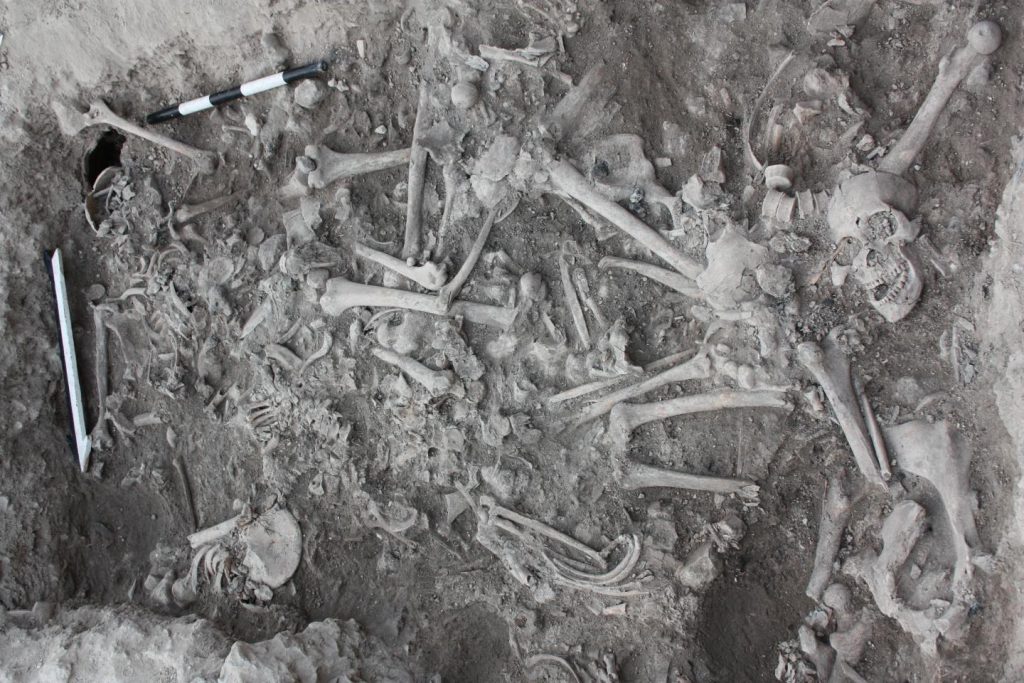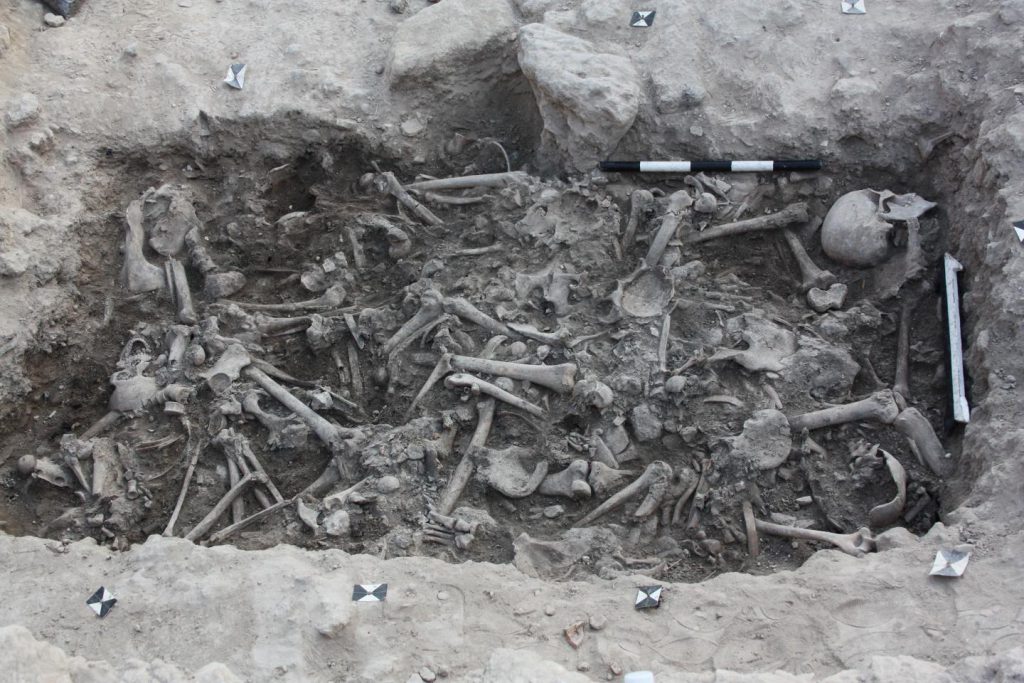Crusaders made love and war, genetic study finds
First genetic study of the Crusaders confirms that warriors mixed and had families with local people in the near East, and died together in battle
The first genetic study of ancient human remains believed to be Crusaders confirms that warriors travelled from western Europe to the near East, where they mixed and had families with local people, and died together in battle. Researchers from the Wellcome Sanger Institute and their collaborators analysed ancient DNA extracted from nine skeletons dating back to the 13th century, which were discovered in a burial pit in Sidon, Lebanon.
The results, published today (18 April) in the American Journal of Human Genetics, confirm that while the Crusaders mixed with local people and recruited them to their cause, their genetic presence in the region was short-lived.
The Crusades were a series of religious wars fought between 1095 and 1291, in which Christian invaders tried to claim the near East. It’s known that nobility led the Crusades, but historical records lack details of the ordinary soldiers who travelled to, lived and died in the near East.
In recent years, archaeologists uncovered 25 skeletons dating back to the 13th century within a burial pit in Sidon, Lebanon. All of those found in the pit were male and had been violently killed during battle, as seen by the blunt force injuries to their skulls and other bones. Their bodies had been disposed of in the pit and burned.
Nearby, an isolated skull was found. The head may have been used as a projectile that was catapulted into the opposition’s camp to spread disease and slash morale, illustrating the brutality of the battles.
Clues found alongside the skeletons in the pit, such as European shoe buckles, a coin and carbon-14 dating analysis, led archaeologists to believe the human remains were Crusaders.
In a new study, researchers at the Wellcome Sanger Institute produced whole-genome sequences of the ancient skeletons’ DNA and confirm they were in fact Crusaders.
The team report that three individuals were Europeans of diverse origins, including Spain and Sardinia, four were near Easterners who had been recruited to the fight, and two individuals had mixed genetic ancestry, suggesting they were the descendants of mixed relationships between Crusaders and near Easterners.
Dr Chris Tyler-Smith, from the Wellcome Sanger Institute, said: “Historical documents tell us the names of the nobility who led the Crusades, but the identities of the soldiers remained a mystery. Genomics gives an unprecedented view of the past and shows the Crusaders originated from western Europe and recruited local people of the near East to join them in battle. The Crusaders and near Easterners lived, fought and died side by side.”
However, the researchers believe the Crusaders’ influence in the region was short-lived as European genetic traces are insignificant in people living in Lebanon today.
When the researchers sequenced the DNA of people living in Lebanon 2,000 years ago during the Roman period, long before the Crusades, they found that today’s Lebanese population is genetically similar to the Roman Lebanese, suggesting the Crusades had no lasting impact on Lebanese genetics.
Dr Marc Haber, from the Wellcome Sanger Institute, said: “The Crusaders travelled to the near East and had relationships with the local people, with their sons later joining to fight their cause. However, after the fighting had finished, the mixed generation married into the local population and the genetic traces of the Crusaders were quickly lost.”
In the study, the team worked with archaeologists at the Sidon Excavation site to transfer bones of the nine skeletons from Lebanon to a laboratory in Cambridge dedicated to ancient DNA. Here, small portions of the surviving 800 year-old DNA were extracted from the temporal bone in the skulls by DNA extraction experts. An ultra-sterile working environment was set up by the scientists to prevent contamination of the samples with their own DNA, which would render them useless.
The ancient DNA samples were particularly difficult to extract and sequence as the bodies had been burned and buried in a warm and humid climate, where DNA degrades quickly. Recent advances in DNA extraction and sequencing technology made studying the ancient and damaged DNA possible.
Dr Claude Doumet-Serhal, Director of the Sidon excavation site in Lebanon, said: “I was thrilled to discover the genetic identities of the people who lived in the near East during the Crusades. Only five years ago, studies like this would not have been possible. The uniting of archaeologists and geneticists creates an incredible opportunity to interpret significant events throughout history.”
###
Publication:
Marc Haber et al. (2019) A transient pulse of genetic admixture from the Crusaders in the Near East identified from ancient genome sequences. American Journal of Human Genetics. DOI: 10.1016/j.ajhg.2019.03.015
Funding:
This study was supported by Wellcome (098051).
The Wellcome Sanger Institute
The Sanger is one of the world’s leading genome and biodata institutes. Through its ability to conduct research at scale, it is able to engage in bold and long-term exploratory projects that are designed to influence and empower science globally. Institute research findings, generated through its own research programmes and through its leading role in international consortia, are being used to develop new diagnostics and treatments for human disease and to understand life on Earth. Find out more at http://www.
About Wellcome
Wellcome exists to improve health by helping great ideas to thrive. We support researchers, we take on big health challenges, we campaign for better science, and we help everyone get involved with science and health research. We are a politically and financially independent foundation.
Press release from the Wellcome Trust Sanger Institute
A history of the Crusades, as told by crusaders’ DNA

History can tell us a lot about the Crusades, the series of religious wars fought between 1095 and 1291, in which Christian invaders tried to claim the Near East. But the DNA of nine 13th century Crusaders buried in a pit in Lebanon shows that there’s more to learn about who the Crusaders were and their interactions with the populations they encountered. The work appears April 18 in The American Journal of Human Genetics.
The remains suggest that the soldiers making up the Crusader armies were genetically diverse and intermixed with the local population in the Near East, although they didn’t have a lasting effect on the genetics of Lebanese people living today. They also highlight the important role ancient DNA can play in helping us understand historical events that are less well documented.
“We know that Richard the Lionheart went to fight in the Crusades, but we don’t know much about the ordinary soldiers who lived and died there, and these ancient samples give us insights into that,” says senior author Chris Tyler-Smith, a genetics researcher at the Wellcome Sanger Institute.
“Our findings give us an unprecedented view of the ancestry of the people who fought in the Crusader army. And it wasn’t just Europeans,” says first author Marc Haber, also of the Wellcome Sanger Institute. “We see this exceptional genetic diversity in the Near East during medieval times, with Europeans, Near Easterners, and mixed individuals fighting in the Crusades and living and dying side by side.”

Archaeological evidence suggested that 25 individuals whose remains were found in a burial pit near a Crusader castle near Sidon, Lebanon, were warriors who died in battle in the 1200s. Based on that, Tyler-Smith, Haber, and their colleagues conducted genetic analyses of the remains and were able to sequence the DNA of nine Crusaders, revealing that three were Europeans, four were Near Easterners, and two individuals had mixed genetic ancestry.
Throughout history, other massive human migrations–like the movement of the Mongols through Asia under Genghis Khan and the arrival of colonial Iberians in South America–have fundamentally reshaped the genetic makeup of those regions. But the authors theorize that the Crusaders’ influence was likely shorter-lived because the Crusaders’ genetic traces are insignificant in people living in Lebanon today. “They made big efforts to expel them, and succeeded after a couple of hundred years,” says Tyler-Smith.
This ancient DNA can tell us things about history that modern DNA can’t. In fact, when the researchers sequenced the DNA of people living in Lebanon 2,000 years ago during the Roman period, they found that today’s Lebanese population is actually more genetically similar to the Roman Lebanese.
“If you look at the genetics of people who lived during the Roman period and the genetics of people who are living there today, you would think that there was just this continuity. You would think that nothing happened between the Roman period and today, and you would miss that for a certain period of time the population of Lebanon included Europeans and people with mixed ancestry,” says Haber.
These findings indicate that there may be other major events in human history that don’t show up in the DNA of people living today. And if those events aren’t as well-documented as the Crusades, we simply might not know about them. “Our findings suggest that it’s worthwhile looking at ancient DNA even from periods when it seems like not that much was going on genetically. Our history may be full of these transient pulses of genetic mixing that disappear without a trace,” says Tyler-Smith.
That the researchers were able to sequence and interpret the nine Crusaders’ DNA at all was also surprising. DNA degrades faster in warm climates, and the remains studied here were burned and crudely buried. “There has been a lot of long-term interest in the genetics of this region, because it has this very strategic position, a lot of history, and a lot of migrations. But previous research has focused mainly on present-day populations, partly because recovering ancient DNA from warm climates is so difficult. Our success shows that studying samples in a similar condition is now possible because of advances in DNA extraction and sequencing technology,” says Haber.
Next, the researchers plan to investigate what was happening genetically in the Near East during the transition from the Bronze Age to the Iron Age.
But they also hope that these kinds of studies will become more commonplace–and more interdisciplinary. “Historical records are often very fragmentary and potentially very biased,” Tyler-Smith says. “But genetics gives us a complementary approach that can confirm some of the things that we read about in history and tell us about things that are not recorded in the historical records that we have. And as this approach is adopted by historians and archaeologists as a part of their field, I think it will only become more and more enriching.”

###
This work was supported by The Wellcome Trust.
The American Journal of Human Genetics, Haber et al.: “A transient pulse of genetic admixture from the Crusaders in the Near East identified from ancient genome sequences” https://www.cell.com/ajhg/fulltext/S0002-9297(19)30111-9
The American Journal of Human Genetics (@AJHGNews), published by Cell Press for the American Society of Human Genetics, is a monthly journal that provides a record of research and review relating to heredity in humans and to the application of genetic principles in medicine and public policy, as well as in related areas of molecular and cell biology. Visit: http://www.
Press release from Cell Press



